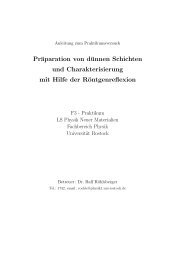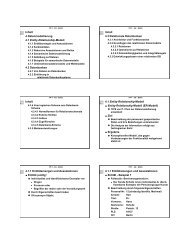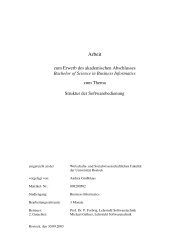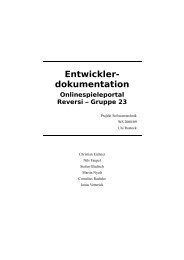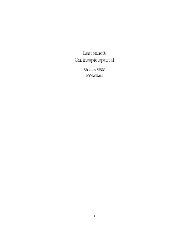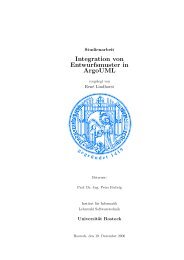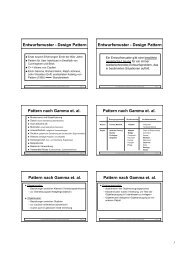paper - Universität Rostock
paper - Universität Rostock
paper - Universität Rostock
Create successful ePaper yourself
Turn your PDF publications into a flip-book with our unique Google optimized e-Paper software.
constructed on the basis of the task model in Fig.1 and revealed the sub-action rechecking the total<br />
list which was added afterwards to the task model (indicated with dotted lines in the figure). “In<br />
SBD new activities are always grounded in current activities” [RC02]. Scenarios as stories support<br />
the transition from current to envisioned models. Taken the scenario in Sect.2, for example, one<br />
can easily imagine that in the envisioned practice the compiling of the total list out of the single<br />
lists for each of the 5 exercises can be done automatically by the software system under<br />
development. It is also of advantage that the system can label the “borderline cases” (the entries of<br />
the students who miss 1 or 2 points to pass the examination). An envisioned task model has to<br />
reflect the application of the software system by the actors.<br />
problem<br />
scenarios<br />
...<br />
task model of the<br />
current practice<br />
specification<br />
of the software<br />
system<br />
design<br />
scenarios<br />
...<br />
task model of the<br />
envisioned practice<br />
test case<br />
scenarios<br />
...<br />
Figure 3: A combination of MBD and SBD<br />
Scenarios as test cases are complete scenarios in the sense of Sect. 4.1. They can be generated<br />
from sub-trees of the action hierarchy as should be underlined by Fig.2. They are useful for<br />
validating a system specification with respect to a task model and vice versa because they describe<br />
the interaction between a user and the system precisely. Scenarios of this kind are rather<br />
comparable with scenarios as paths through use cases.<br />
Fig.3 illustrates possible applications of scenarios to supplement a model-based design process.<br />
5 Summary<br />
A combination of SBD and MBD to improve the software design process was shown. Task<br />
models play a mediating role. They supply a general description which is useful for constructing<br />
scenarios on the one side but also for deriving formal system specifications on the other side. A<br />
distinction between scenarios as stories and scenarios as test cases was proposed and their<br />
different fields of application were explored. There are a lot of open questions. The problem of<br />
choosing a representative set of test case scenarios out of a possibly infinite set is only one of<br />
them. The interested reader is referred to [FD03] where tool support is described.<br />
References<br />
[Car02] J.M.Carroll: Scenarios and Design Cognition, Proc. of the Int. Conf. On Requirements<br />
Engineering RE2002, Essen, Germany.<br />
[RC02] M.B.Rosson, J.M.Carroll: Usability Engineering – Scenario-Based Development of<br />
Human-Computer Interaction, Morgan Kaufmann Publishers, 2002.<br />
[FD03] P.Forbrig, A.Dittmar: Interfacing Business Object and User Models with Action Models<br />
in this Proceedings of HCI 2003.<br />
[Dit02] A.Dittmar: Ein formales Metamodell für den aufgabenbasierten Entwurf interaktiver<br />
Systeme, PhD-Thesis, Universität <strong>Rostock</strong>, 2002.



